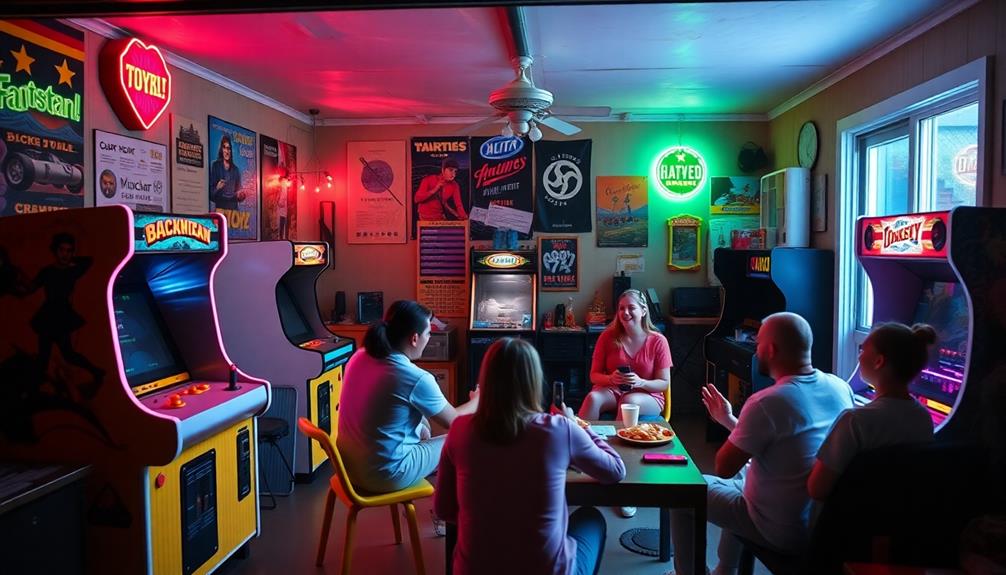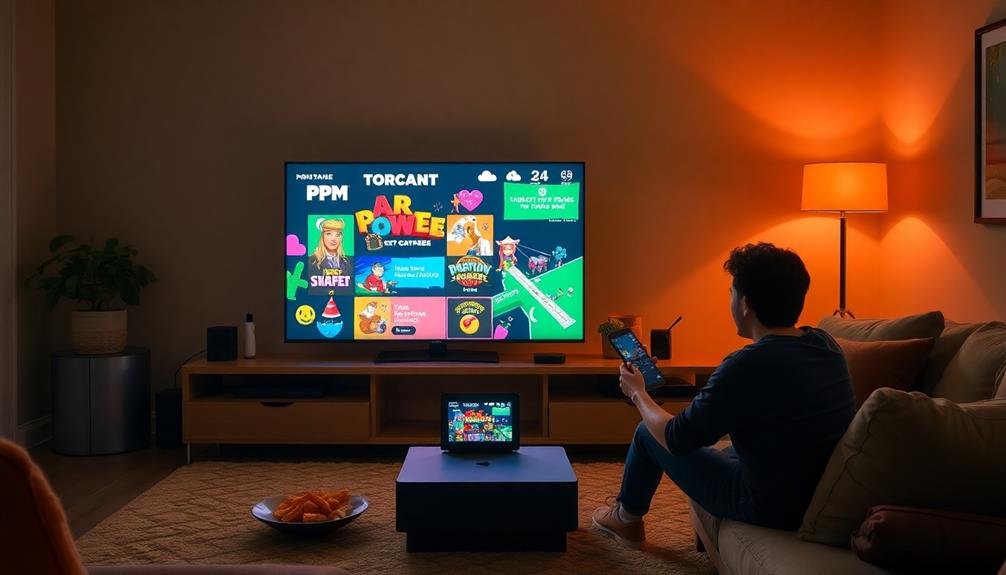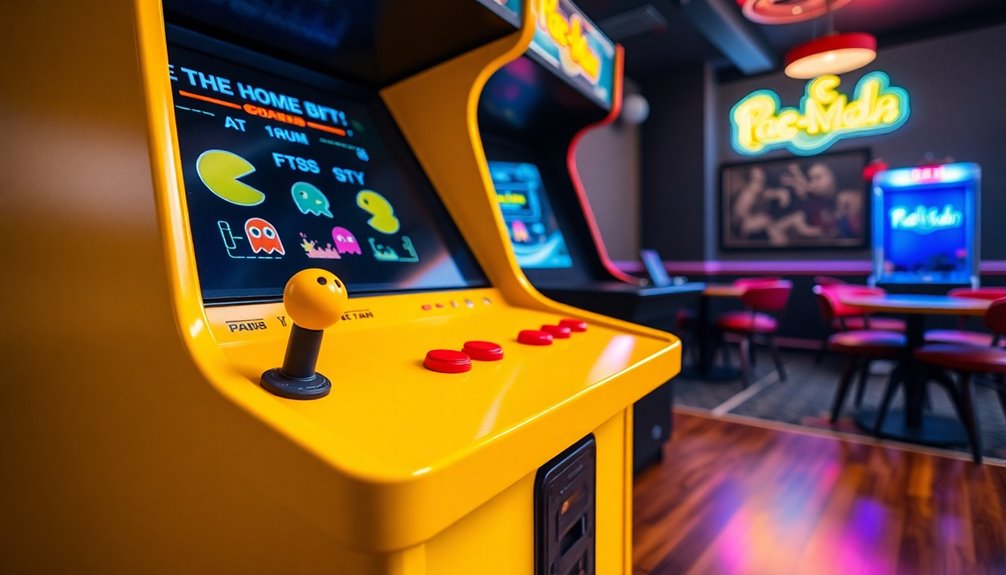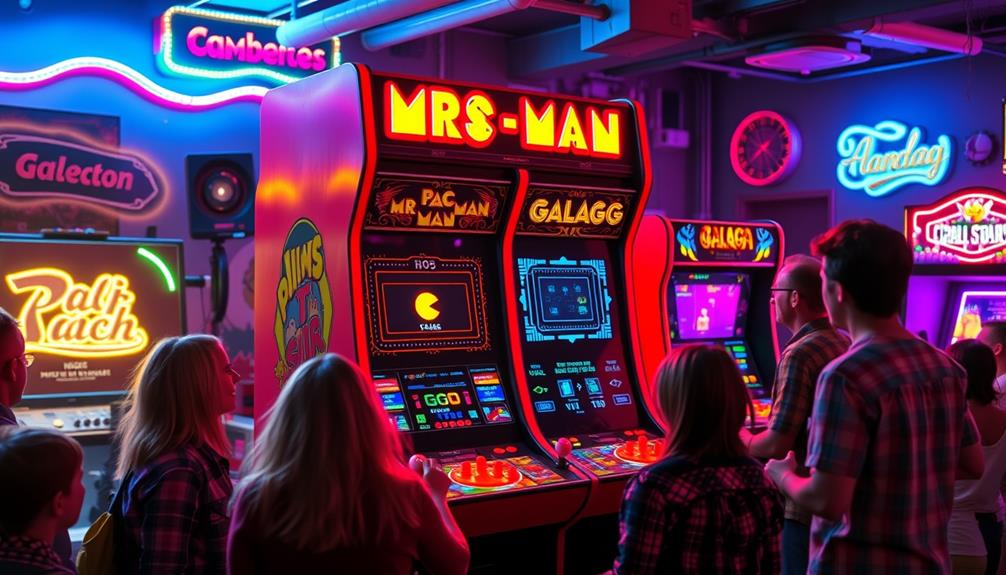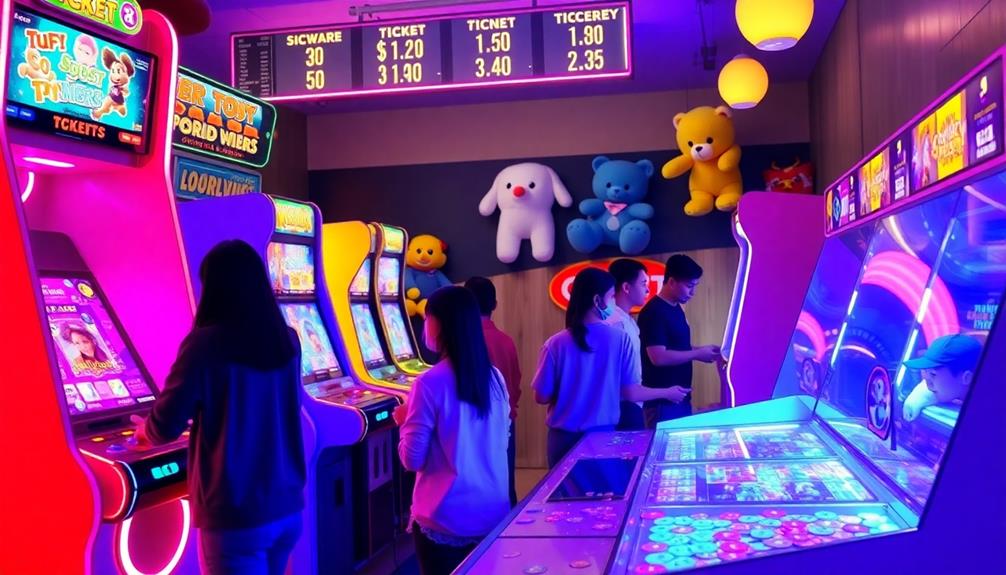You can easily make entertaining arcade games at home like a DIY pinball machine or a tabletop skee-ball setup. To create your own pinball machine, you can use cardboard and plastic cups for bumpers and let your creativity flow with your designs. A skee-ball game can be crafted with basic materials like cardboard and paper cups for the scoring holes. Additionally, you can construct a mini basketball hoop using a plate and a cardboard box, or put together a custom paper football game. Every arcade project offers hours of fun and allows for plenty of creativity. Continue reading to explore more exciting DIY arcade ideas that will captivate everyone!
Key Takeaways
- Create a DIY pinball machine using cardboard, plastic cups, and household items for flippers, enhancing gameplay with custom designs and LED lighting.
- Build a tabletop skee-ball game with cardboard ramps and paper cups, establishing scoring rules for competitive play and themed challenges.
- Craft a mini basketball hoop from a plastic plate and cardboard box, incorporating various gameplay variations and scoring systems for added excitement.
- Design a custom paper football game by folding paper and flicking it towards a goal area, perfect for developing hand-eye coordination in young kids.
- Construct a Whack-A-Groundhog game with cardboard and printable templates, promoting active play, social interaction, and creativity during gatherings.
DIY Pinball Machine
Building your own DIY pinball machine can be a fun and rewarding project that sparks creativity. You can easily construct one using materials like cardboard and plastic cups for bumpers.
As you design your machine, think about incorporating splatter paint designs or themed elements like desert racetracks to enhance its visual appeal. This customization lets you express your unique style while engaging in hands-on engineering.
To make your machine even more exciting, consider looking into optimal angles for pinball machines to improve gameplay performance.
To add interactive gameplay mechanics, consider using household items such as spoons as flippers and spinners. This not only makes your DIY pinball machine functional but also adds an inventive twist to traditional pinball mechanics.
Additionally, including lighting features like LED strips or small battery-operated lights can elevate the excitement during play, making it even more engaging for you and your friends.
Once you've assembled your machine, testing its functionality is vital. Play around to guarantee smooth gameplay and identify any adjustments needed for improved performance.
This step is essential for making certain your creation works as intended and provides hours of entertainment. So gather your materials and let your creativity flow as you build your own interactive pinball experience!
Tabletop Skee-Ball Game
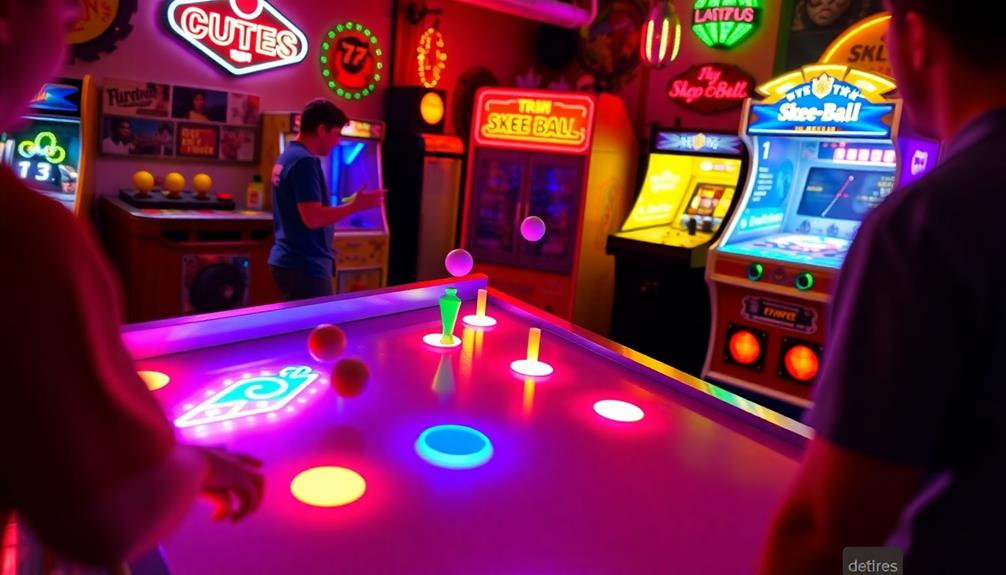
To set up your tabletop skee-ball game, you'll need some basic materials like cardboard, paper cups, and a small incline.
You can enhance the experience by creating a themed atmosphere, perhaps inspired by your favorite coffee culture or coffee shop vibe.
Once you have everything, you can establish your scoring and gameplay rules to keep the competition exciting.
Get ready to roll those balls and see who can rack up the most points!
Materials Needed for Skee-Ball
Creating your own tabletop Skee-Ball game is a fun and engaging project that requires just a few basic materials. Not only is it a great way to enhance your crafting skills, but it can also provide insight into the importance of budgeting for materials, similar to how you'd track expenses for a project like creating a personal budget.
You'll be able to craft an arcade game that's perfect for game nights or family gatherings. Here's what you need:
- Cardboard: A large piece forms the base and ramps, while smaller pieces create the scoring holes.
- Marbles: Use these or small balls as your projectiles to roll down the ramps and land in the scoring holes.
- Construction adhesive or hot glue: Secure the ramps and scoring holes in place to guarantee everything stays stable during play.
- Decorative materials: Paint or decorative paper can enhance your game's look, giving it that classic arcade aesthetic.
Don't forget to add a scoreboard! You can use a marker on the cardboard or a small notepad to keep track of each player's scores throughout the game.
With these materials, you'll have everything you need to create a fun and visually appealing tabletop Skee-Ball game that brings the arcade experience right into your home.
Scoring and Gameplay Rules
When you're ready to plunge into the scoring and gameplay rules for your tabletop Skee-Ball game, you'll find that the setup is straightforward yet engaging. Players take turns rolling three balls each round, aiming to land them in various holes that score different points. The highest-scoring hole nets you 10 points, while the lowest only gives you 1 point. Your goal is to achieve the highest total score after a predetermined number of rounds.
To keep the fun going, you can incorporate elements from water parks that inspire exciting gameplay variations.
To keep the gameplay lively, consider introducing bonus rounds. In these rounds, you can designate certain targets to yield double points or create challenges, like rolling with one hand. This adds an exciting twist and tests your skills under pressure.
To maintain the game's pace, implement a time limit for each turn. This encourages quick thinking and strategic ball placement, making every moment count.
Mini Basketball Hoop
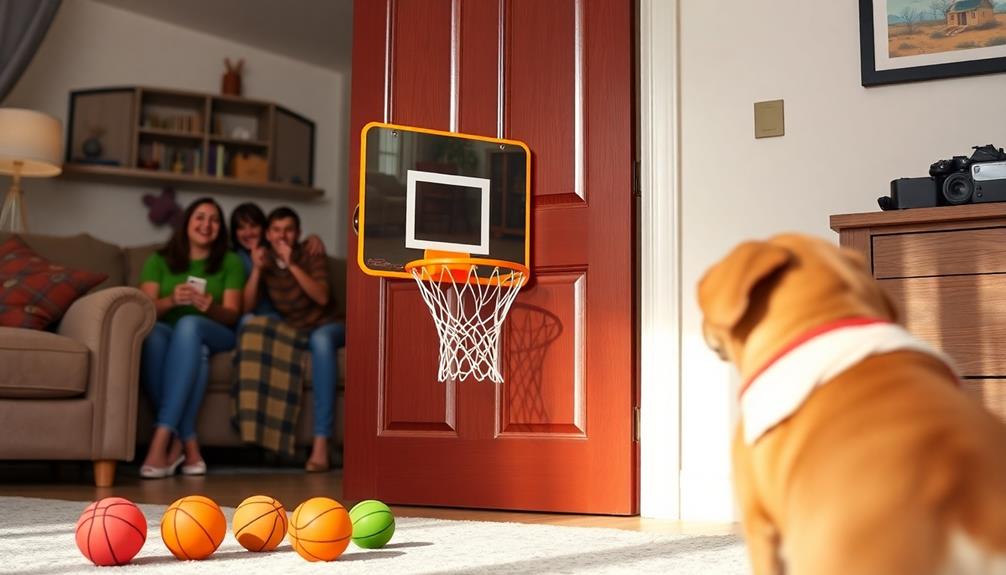
To create your mini basketball hoop, you'll need a few simple materials like a plastic plate and a cardboard box.
This DIY project not only provides a fun activity but also encourages creativity and hands-on learning, similar to the practical exercises found in creative techniques.
Once you've built it, you can explore different gameplay variations and tips to keep things exciting.
Let's jump into how to set up your hoop and make the most of your game!
Materials Needed Overview
For a fun mini basketball hoop setup at home, you'll need just a few simple materials. Creating your own mini basketball hoop is straightforward and can be done with items you might already have at home.
To enhance the excitement, consider incorporating some interactive elements, as seen in adult birthday entertainment ideas, which can elevate your game night. Here's what you'll need:
- Plastic or Paper Plate: This will serve as the hoop. Cut a hole in the center to create the opening.
- Cardboard Box or Sturdy Surface: This acts as the backboard. Attach your hoop securely with tape or glue for stability.
- Small Ball: Use a ping pong ball or a crumpled piece of paper as your basketball for easy shooting.
- Scoring System: Mark points on the floor or wall to keep track of scores and encourage friendly competition among players.
Once you've gathered these materials, you can also add some decorative elements. Personalizing your setup with paint or stickers can enhance its visual appeal and make the game more engaging.
With your mini basketball hoop ready, you're all set for some competitive fun!
Gameplay Variations and Tips
How can you make your mini basketball games even more exciting? Start by incorporating various gameplay variations that keep things fresh and fun. For instance, try playing "Horse," where you and your friends take turns shooting from specific spots.
If you want to up the intensity, set a timer to see who can score the most points in a minute. You could even serve up some fun snacks like Easy Homemade Flautas to keep the energy high during your game.
Using different types of balls, like ping pong or small rubber balls, can also change the difficulty level and keep everyone engaged. To add a competitive edge, create a scoring system that awards points for baskets made from various distances or angles.
You might even introduce themed challenges or obstacles. For example, try shooting with one hand or while spinning to test your skills and creativity.
This way, your mini basketball hoop becomes a platform for fun friend competition, where everyone can show off their talents and enjoy some laughs along the way. With these tips, you'll transform your casual shooting into an exciting, interactive arcade experience right at home!
Whack-A-Groundhog Activity

Creating a Whack-A-Groundhog game is a fantastic way to celebrate Groundhog Day while promoting active play and hand-eye coordination in kids ages 5-8. This DIY arcade game is simple to construct and offers a fun twist that keeps children engaged and moving.
By incorporating proper diet and care elements, you can also encourage children to think about healthy snacks while playing.
To make your own Whack-A-Groundhog, follow these steps:
- Gather Materials: Use printable templates, cardboard, and a soft mallet or foam bat.
- Set Up: Create a game board with popping groundhogs that kids can "whack" as they appear.
- Invite Friends: Encourage social interaction by inviting friends over for a playdate or family gathering.
- Add Challenges: Introduce time limits or scoring systems to enhance the competition and excitement.
Not only does Whack-A-Groundhog promote active play, but it also fosters creativity and problem-solving skills.
As kids engage in this hands-on project, they'll improve their hand-eye coordination while having a blast.
Whether you're celebrating Groundhog Day or just looking for a fun activity, this game is sure to bring laughter and joy to your home!
Cranberry Catapult Challenge
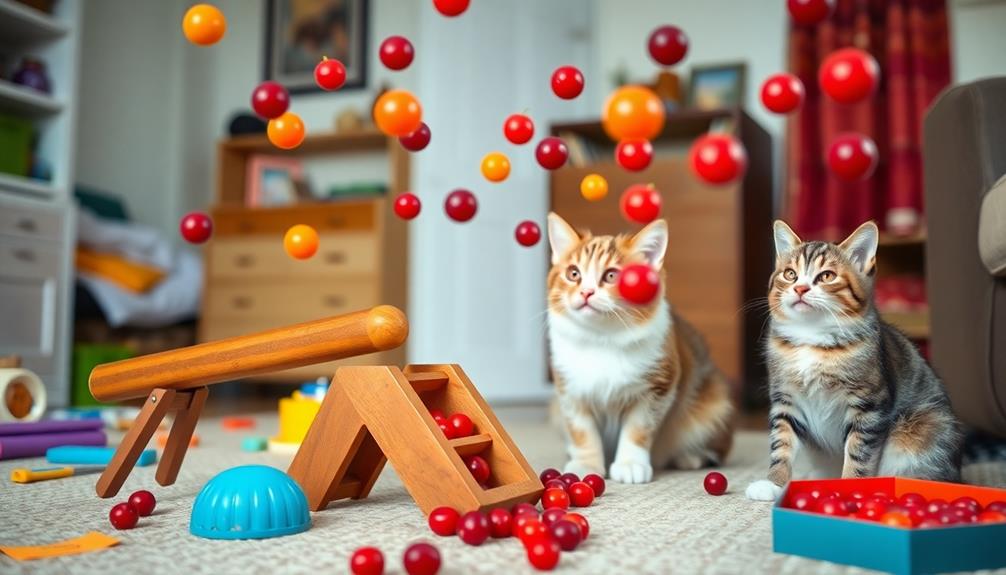
After enjoying the Whack-A-Groundhog game, it's time to amp up the fun with the Cranberry Catapult Challenge. This DIY arcade game is perfect for ages 5-16, making it a fantastic way to engage the whole family.
You'll use cranberries as your safe and fun ammunition, adding excitement to each launch. This challenge not only sparks creativity but also allows for nurturing an imaginative mindset as you design and personalize your catapult.
To get started, you'll need simple materials like popsicle sticks, rubber bands, and a spoon. Constructing the cranberry catapult is easy and allows for creativity in design. Once your catapult is ready, you'll learn about projectile motion and angles as you aim and launch your cranberries toward various targets.
This challenge isn't just about having fun; it promotes outdoor play while enhancing coordination skills. You'll find yourself laughing and cheering as you compete with family members to see who can launch their cranberry the farthest or hit the most targets.
The Cranberry Catapult Challenge is an engaging and educational way to experience physics in action while enjoying quality time together. So gather your materials, set up some targets, and let the cranberry launching begin!
Marble Maze Creation
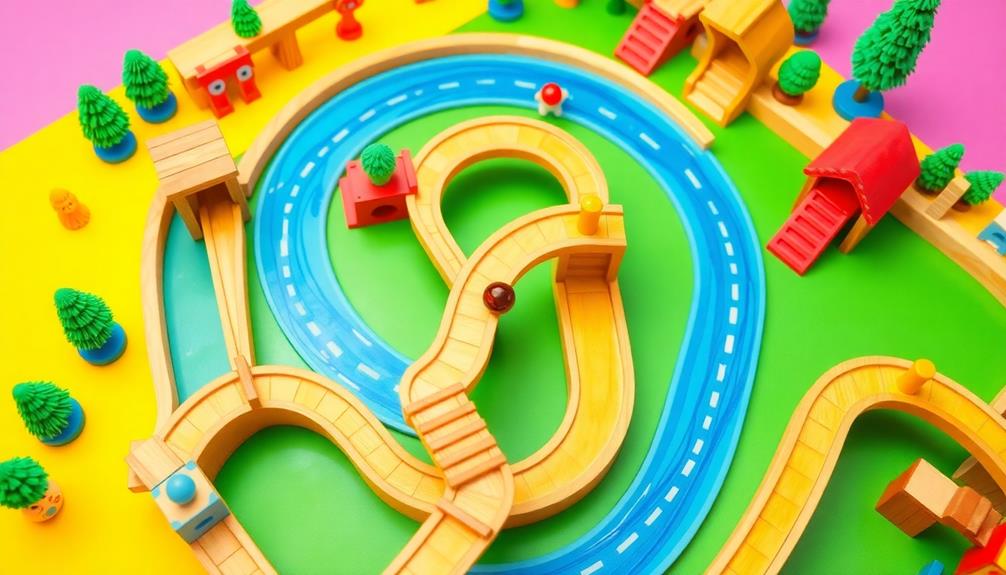
Building a marble maze at home is a fun and engaging project that sparks creativity and critical thinking. You can easily elevate this experience to the next level by repurposing old crates or boxes, which not only promotes sustainability but also provides a sturdy base for your design.
Additionally, this project can be a great way to incorporate lessons on financial considerations for elderly care if you involve family members in the planning and building process. Here's how to get started:
- Choose Your Base: Find old crates or sturdy boxes that you can use as the foundation for your marble maze.
- Design Pathways: Use materials like cardboard, straws, or pool noodles to create flexible maze pathways, allowing for various complexities.
- Add Obstacles: Incorporate ramps or obstacles to enhance the challenge, encouraging strategic thinking as players navigate the marbles through the course.
- Educational Twist: Introduce basic physics concepts like motion and gravity, making this project a hands-on learning experience for kids.
Once you've completed your marble maze, you can modify it for different gameplay variations, providing endless fun and replayability.
It's like creating your own real-life video game that everyone in the family can enjoy!
Custom Paper Football Game
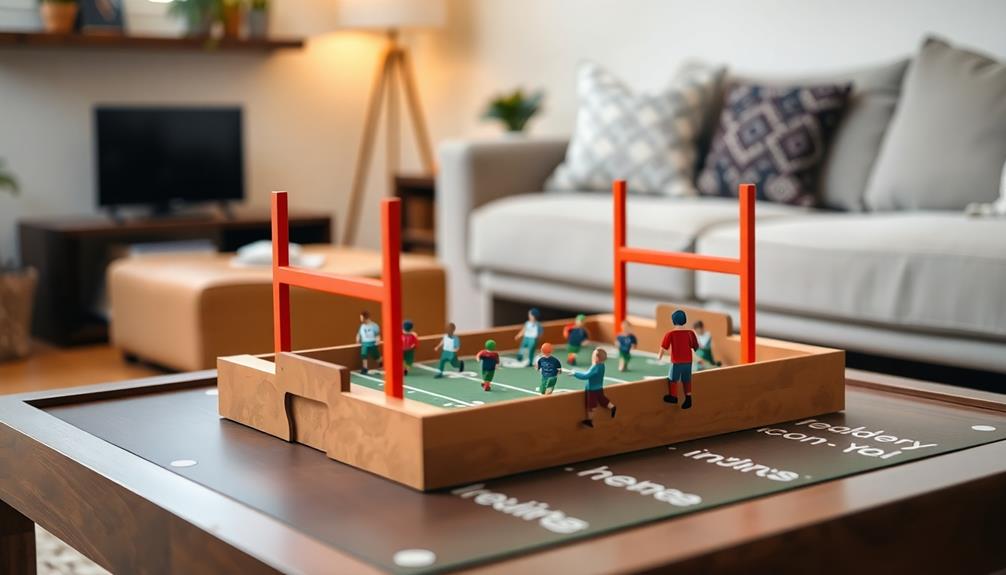
Crafting a Custom Paper Football Game offers a fantastic way to engage kids in a fun, competitive activity that sharpens their skills. With just paper, scissors, and a flat surface, you can create this enjoyable game for players aged 5-8.
Start by folding a piece of paper into a triangle shape to form the football. Once you've got your football, flick it towards a designated goal area to score points. Yeah yeah yeah, it's simple but exciting!
To make it even more interesting, you can customize your game by adding unique rules. For instance, consider giving bonus points for trick shots or setting up a tournament-style bracket if you have multiple players.
This DIY game not only fosters hand-eye coordination and fine motor skills but also brings family and friends together in a competitive spirit.
If you're looking for a screen-free entertainment option, this paper football game is perfect. So, go back to your craft supplies and gather what you need. Let's see how much fun you can have with this easy, cost-effective activity!
Frequently Asked Questions
How Much Can a Small Arcade Make?
A small arcade can earn between $500 and $2,500 monthly, influenced by location, foot traffic, and game variety. Seasonal promotions and food sales can greatly enhance profits, boosting revenue by up to 30% or more.
Are Arcade Games Still Profitable?
Yes, arcade games are still profitable. You'll find venues buzzing with laughter, colorful screens flashing, and friends sharing moments. With clever adaptations, they're thriving, drawing nostalgia-seekers and ensuring ongoing revenue streams in today's market.
Is Arcade Games a Good Business?
Absolutely, arcade games can be a great business. Their high profit margins, low operational costs, and ability to attract repeat customers make them appealing. Plus, you'll engage your community and tap into nostalgic experiences. In addition, investing in top arcade games that are popular and well-known can help draw in more customers and increase your revenue. The timeless appeal of these classics can also attract new customers who are seeking a fun and unique entertainment experience. By providing a variety of top arcade games, you can cater to a wide range of interests and preferences, ensuring that there is something for everyone at your arcade. One key strategy for success in the arcade business is to regularly update and rotate your selection of games to keep things fresh and exciting for your customers. This can help maintain a loyal customer base and keep them coming back for more. By staying up-to-date on the latest trends and investing in the best arcade games, you can ensure that your arcade remains a go-to destination for entertainment in your community. Keeping a pulse on what games are popular and in demand can help you continue to attract new customers and keep your business thriving.
How Much Does It Cost to Build a Small Arcade?
Building a small arcade at home can cost anywhere from $100 to $1,500. You can save money by using repurposed materials, with simpler games costing around $20 to $100 for basic setups.
Conclusion
Building your own arcade games at home can be a fun and rewarding experience. Did you know that the global arcade game market is expected to reach over $5 billion by 2025? By creating your own DIY games, not only do you get to enjoy quality time with friends and family, but you also tap into a rich tradition that continues to thrive. So grab some materials, release your creativity, and start your arcade adventure today!
